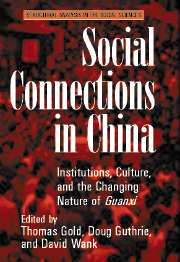Book contents
- Frontmatter
- Contents
- Contributors
- List of Figures and Tables
- Prologue
- Introduction
- Methodological and Conceptual Considerations
- New Substantive Studies of Guanxi
- 4 Guanxi in Business Groups: Social Ties and the Formation of Economic Relations
- 5 Business-State Clientelism in China: Decline or Evolution?
- 6 Institutional Holes and Job Mobility Processes: Guanxi Mechanisms in China's Emergent Labor Markets
- 7 Youth Job Searches in Urban China: The Use of Social Connections in a Changing Labor Market
- 8 Face, Norms, and Instrumentality
- 9 Guanxi and the PRC Legal System: From Contradiction to Complementarity
- 10 “Idle Talk”: Neighborhood Gossip as a Medium of Social Communication in Reform Era Shanghai
- Conclusions
- References
- Index
4 - Guanxi in Business Groups: Social Ties and the Formation of Economic Relations
Published online by Cambridge University Press: 30 July 2009
- Frontmatter
- Contents
- Contributors
- List of Figures and Tables
- Prologue
- Introduction
- Methodological and Conceptual Considerations
- New Substantive Studies of Guanxi
- 4 Guanxi in Business Groups: Social Ties and the Formation of Economic Relations
- 5 Business-State Clientelism in China: Decline or Evolution?
- 6 Institutional Holes and Job Mobility Processes: Guanxi Mechanisms in China's Emergent Labor Markets
- 7 Youth Job Searches in Urban China: The Use of Social Connections in a Changing Labor Market
- 8 Face, Norms, and Instrumentality
- 9 Guanxi and the PRC Legal System: From Contradiction to Complementarity
- 10 “Idle Talk”: Neighborhood Gossip as a Medium of Social Communication in Reform Era Shanghai
- Conclusions
- References
- Index
Summary
INTRODUCTION
The role that guanxi plays in organizing social and economic interactions in China has been the subject of considerable debate among scholars, particularly since the beginning of reform (Bian 1997, 1999; Gold 1985; Guthrie 1998a; Kipnis 1997; Yan 1996a; Yang 1994). In this chapter, I examine the role that guanxi played in the emergence of firm-to-firm lending and trade relations in the early stages of reform. The structure of lending and trade relations is one of the fundamental defining features of any economic system. The nature of relations among buyers and sellers of commercial goods and the borrowers and lenders of financial resources determines a great deal not only about flows of resources in an economy but also about the financial performance of firms and entire regions (Cool and Schendel 1987; Haveman 1992; Lincoln, Gerlach, and Ahmadjian 1996), the economic and political influence of organizations (Lincoln, Gerlach, and Takahashi 1992; Mizruchi 1989, 1992), power and dependence relations among firms (Mintz and Schwartz 1985; Pfeffer and Salancik 1978; Scott 1991), and the relative economic and social advantages enjoyed by workers in those firms (Mizruchi 1992; Pfeffer 1981).
From the beginning of China's economic reform, lending and trade relations among firms were dismantled and rebuilt. As the state decreased central planning and reduced its role in the management of firms, managers became responsible for finding productive inputs, for acquiring capital, and for finding markets for finished products for the first time in decades.
- Type
- Chapter
- Information
- Social Connections in ChinaInstitutions, Culture, and the Changing Nature of Guanxi, pp. 77 - 96Publisher: Cambridge University PressPrint publication year: 2002
- 12
- Cited by



